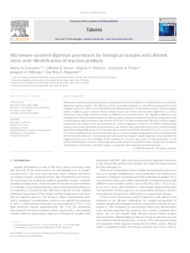Microwave-assisted digestion procedures for biological samples with diluted nitric acid: identification of reaction products.
Microwave-assisted digestion procedures for biological samples with diluted nitric acid: identification of reaction products.
Autoria: GONZALEZ, M. H.; SOUZA, G. B. D.; OLIVEIRA, R. V. DE; FORATO, L. A.; NÓBREGA, J. A.; NOGUEIRA, A. R. de A.
Resumo: Microwave-assisted sample preparation using diluted nitric acid solutions is an alternative procedure for digesting organic samples. The efficiency of this procedure depends on the chemical properties of the samples and in this work it was evaluated by the determination of crude protein amount, fat and original carbon. Soybeans grains, bovine blood, bovine muscle and bovine viscera were digested in a cavity-microwave oven using oxidant mixtures in different acid concentrations. The digestion efficiency was evaluated based on the determination of residual carbon content and element recoveries using inductively coupled plasma optical emission spectrometry (ICP OES). In order to determine the main residual organic compounds, the digests were characterized by nuclear magnetic resonance ((1)H NMR). Subsequently, studies concerning separation of nitrobenzoic acid isomers were performed by ion pair reversed phase liquid chromatography using a C18 stationary phase, water:acetonitrile:methanol (75:20:5, v/v/v)+0.05% (v/v) TFA as mobile phase and ultraviolet detection at 254 nm. Sample preparation based on diluted acids proved to be feasible and a recommendable alternative for organic sample digestion, reducing both the reagent volumes and the variability of the residues as a result of the process of decomposition. It was shown that biological matrices containing amino acids, proteins and lipids in their composition produced nitrobenzoic acid isomers and other organic compounds after cleavage of chemical bonds.
Ano de publicação: 2009
Tipo de publicação: Artigo de periódico
Unidade: Embrapa Pecuária Sudeste
Observações
1 - Por padrão são exibidas publicações dos últimos 20 anos. Para encontrar publicações mais antigas, configure o filtro ano de publicação, colocando o ano a partir do qual você deseja encontrar publicações. O filtro está na coluna da esquerda na busca acima.
2 - Para ler algumas publicações da Embrapa (apenas as que estão em formato ePub), é necessário ter, no celular ou computador, um desses softwares gratuitos. Sistemas Android: Google Play Livros; IOS: iBooks; Windows e Linux: software Calibre.
Acesse outras publicações
Acesse a Base de Dados da Pesquisa Agropecuária (BDPA) para consultar o acervo completo das bibliotecas da Embrapa.

